Latitude, Planting Density, and Soil Available Potassium Are the Key Driving Factors of the Cotton Harvest Index in Arid Regions
Abstract
1. Introduction
2. Materials and Methods
2.1. Experimental Site
2.2. Sampling and Measurements
2.2.1. Cotton Sampling and Lint Harvest Index Calculation
2.2.2. Climatic–Geographic Factors
2.2.3. Agronomic Management Factors
2.2.4. Soil Nutrient Factors
2.3. Data Analysis
3. Results
3.1. The Harvest Index and Spatial Distribution of Cotton in Arid Areas
3.2. Key Drivers of the Cotton Harvest Index in Arid Zones
3.2.1. Heat Map of the Intra-Group Correlation of the Cotton Harvest Index and Its Influencing Factors
3.2.2. Importance Analysis of Influencing Factors Based on the Random Forest Model
3.2.3. The Effects of Influencing Factors on the Cotton Harvest Index Analyzed Based on the Structural Equation Model (SEM)
3.2.4. Regression Analysis of Cotton Lint Yield, Cotton Stalk Yield, and Available Potassium with the Cotton Harvest Index
4. Discussion
4.1. The Cotton Harvest Index and Its Spatial Distribution in Arid Areas
4.2. Key Drivers of the HI in Arid Zones
5. Conclusions
Supplementary Materials
Author Contributions
Funding
Data Availability Statement
Acknowledgments
Conflicts of Interest
Abbreviations
| HI | harvest index |
| Lon | longitude |
| Lat | latitude |
| PHt | plant height |
| ASL | altitude above sea level |
| AGB | aboveground biomass |
| LY | lint yield |
| CSY | cotton stalk yield |
| Den | density |
| LP | lint percentage |
| GDDs | growing degree days |
| SOM | soil organic matter |
| TN | Total Nitrogen in Soil |
| TP | Total Phosphorus in Soil |
| TK | Total Potassium in Soil |
| ANS | Alkalihydrolyzable Nitrogen in Soil |
| AP | Available Phosphorus in Soil |
| AK | available potassium in soil |
| EC | soil electrical conductivity |
| SMC | soil moisture content |
| BD | soil bulk density |
| DMA | aboveground biomass dry matter accumulation |
| DEM | Digital Elevation Model |
| ME | Mean Error |
| RMSE | Root Mean Square Error |
| RMSSE | Normalized Root Mean Square Error |
| RF | random forest |
References
- Jans, Y.; von Bloh, W.; Schaphoff, S.; Müller, C. Global Cotton Production under Climate Change—Implications for Yield and Water Consumption. Hydrol. Earth Syst. Sci. 2021, 25, 2027–2044. [Google Scholar] [CrossRef]
- Li, N.; Lin, H.; Wang, T.; Li, Y.; Liu, Y.; Chen, X.; Hu, X. Impact of Climate Change on Cotton Growth and Yields in Xinjiang, China. Field Crops Res. 2020, 247, 107590. [Google Scholar] [CrossRef]
- Cai, C.; Wang, Z.; Ma, L.; Xu, Z.; Yu, J.; Li, F. Cotton Stalk Valorization towards Bio-Based Materials, Chemicals, and Biofuels: A Review. Renew. Sustain. Energy Rev. 2024, 202, 114651. [Google Scholar] [CrossRef]
- Zhou, Y.; Li, F.; Xin, Q.; Li, Y.; Lin, Z. Historical Variability of Cotton Yield and Response to Climate and Agronomic Management in Xinjiang, China. Sci. Total Environ. 2024, 912, 169327. [Google Scholar] [CrossRef]
- Civelek Yoruklu, H.; Koroglu, E.O.; Ozdemir, O.K.; Demir, A.; Ozkaya, B. Bioenergy Production from Cotton Straws Using Different Pretreatment Methods. Int. J. Hydrogen Energy 2020, 45, 34720–34729. [Google Scholar] [CrossRef]
- Li, S.; Song, H.; Hu, J.; Yang, H.; Zou, J.; Zhu, Y.; Tang, Z.; Chen, H. CO2 Gasification of Straw Biomass and Its Correlation with the Feedstock Characteristics. Fuel 2021, 297, 120780. [Google Scholar] [CrossRef]
- Palamutcu, S.; Devrent, N. Mini Review on Organic Cotton. J. Text. Eng. Fash. Technol. 2017, 3, 610–614. [Google Scholar] [CrossRef][Green Version]
- Xiao, W.; Wang, S.; Wei, B.; Wang, J.; Chen, L.; Liu, K.; Wang, T. Effect of Temperature and Pressure on the Transformation Characteristics of Inorganic Elements in Cotton Straw Ash. Fuel 2023, 340, 127443. [Google Scholar] [CrossRef]
- Qian, B.; Shao, C.; Yang, F. Spatial Suitability Evaluation of the Conversion and Utilization of Crop Straw Resources in China. Environ. Impact Assess. Rev. 2024, 105, 107438. [Google Scholar] [CrossRef]
- Reddy, G.V.N.; Reddy, M.R. Effects of Ammoniation and Processing of Cotton Straw as the Sole Source of Roughage in Complete Feeds on Ruman Characteristics with Murrah Buffaloes. Anim. Feed Sci. Technol. 1986, 14, 95–102. [Google Scholar] [CrossRef]
- Kirubanath, K.; Narsimha Reddy, D.; Nagalakshmi, D. Effect of Processing Cotton Straw Based Complete Diet with Expander-Extruder on Performance of Crossbred Calves. Asian-Australas. J. Anim. Sci. 2003, 16, 1572–1576. [Google Scholar] [CrossRef]
- Patel, H.; Maiti, S.; Müller, F.; Maiti, P. Sustainable Methodology for Production of Potassic Fertilizer from Agro-Residues: Case Study Using Empty Cotton Boll. J. Clean. Prod. 2019, 215, 22–33. [Google Scholar] [CrossRef]
- Zhou, L.; Xie, Y.; Wang, X.; Li, P.; Liu, Y.; Wang, Z.; Dai, J.; Zhang, H.; Yang, X. Influence of Different Microbial Inoculants on Nitrogen Retention and Diazotroph Community Succession during Cotton Straw Composting. Process Saf. Environ. Prot. 2023, 172, 882–893. [Google Scholar] [CrossRef]
- Qaim, M. Bt Cotton, Yields and Farmers’ Benefits. Nat. Plants 2020, 6, 1318–1319. [Google Scholar] [CrossRef]
- Nouri, A.; Yoder, D.C.; Raji, M.; Ceylan, S.; Jagadamma, S.; Lee, J.; Walker, F.R.; Yin, X.; Fitzpatrick, J.; Trexler, B.; et al. Conservation Agriculture Increases the Soil Resilience and Cotton Yield Stability in Climate Extremes of the Southeast US. Commun. Earth Environ. 2021, 2, 155. [Google Scholar] [CrossRef]
- Cordeiro, L.F.d.S.; Cordeiro, C.F.d.S.; Ferrari, S. Cotton Yield and Boron Dynamics Affected by Cover Crops and Boron Fertilization in a Tropical Sandy Soil. Field Crops Res. 2022, 284, 108575. [Google Scholar] [CrossRef]
- Liu, X.; Yan, F.; Wu, L.; Zhang, F.; Yin, F.; Abdelghany, A.E.; Fan, J.; Xiao, C.; Li, J.; Li, Z. Leaching Amount and Timing Modified the Ionic Composition of Saline-Alkaline Soil and Increased Seed Cotton Yield under Mulched Drip Irrigation. Field Crops Res. 2023, 299, 108988. [Google Scholar] [CrossRef]
- Zhang, J.; Wang, H.; Feng, D.; Cao, C.; Zheng, C.; Dang, H.; Li, K.; Gao, Y.; Sun, C. Evaluating the Impacts of Long-Term Saline Water Irrigation on Soil Salinity and Cotton Yield under Plastic Film Mulching: A 15-Year Field Study. Agric. Water Manag. 2024, 293, 108703. [Google Scholar] [CrossRef]
- Chen, J.; Engbersen, N.; Stefan, L.; Schmid, B.; Sun, H.; Schöb, C. Diversity Increases Yield but Reduces Harvest Index in Crop Mixtures. Nat. Plants 2021, 7, 893–898. [Google Scholar] [CrossRef]
- Donald, C.M.; Hamblin, J. The Biological Yield and Harvest Index of Cereals as Agronomic and Plant Breeding Criteria. In Advances in Agronomy; Brady, N.C., Ed.; Academic Press: Cambridge, MA, USA, 1976; Volume 28, pp. 361–405. [Google Scholar]
- Unkovich, M.; Baldock, J.; Forbes, M. Chapter 5—Variability in Harvest Index of Grain Crops and Potential Significance for Carbon Accounting: Examples from Australian Agriculture. In Advances in Agronomy; Academic Press: Cambridge, MA, USA, 2010; Volume 105, pp. 173–219. [Google Scholar]
- Conaty, W.C.; Constable, G.A. Factors Responsible for Yield Improvement in New Gossypium Hirsutum L. Cotton Cultivars. Field Crops Res. 2020, 250, 107780. [Google Scholar] [CrossRef]
- Fu, Z.; Zhi, Z. Harvest index of Chinese crops. Agric. Sci. China 1990, 2, 83–87. [Google Scholar]
- Guang, X.; Xiao, W.; Dong, H. Harvest index and straw coefficient of non-cereal field crops in China. J. China Agric. Univ. 2011, 16, 9–17. [Google Scholar]
- Xue, W.; Li, X.; Zeng, F. Inter-Annual Variations of Seed Cotton Yield in Relation to Soil Organic Carbon and Harvest Index in Reclaimed Desertified Land. Field Crops Res. 2021, 272, 108267. [Google Scholar] [CrossRef]
- Singh, J.; Gamble, A.V.; Brown, S.; Campbell, B.T.; Jenkins, J.; Koebernick, J.; Bartley, P.C.; Sanz-Saez, A. 65 Years of Cotton Lint Yield Progress in the USA: Uncovering Key Influential Yield Components. Field Crops Res. 2023, 302, 109058. [Google Scholar] [CrossRef]
- Xu, Z.; Yu, B.; Hong, W.; Chun, G.; Lei, W.; Ya, W. Estimation and Suitability Evaluation of Cotton Stalk Resources in China. In Proceedings of the 17th Annual Meeting of the China Association for Science and Technology—15 International Symposium on Technological Innovation and Investment and Financing of Emerging Green Industries; China Association for Science and Technology, Guangdong Provincial People’s Government: Guangzhou, China, 2015; p. 7. [Google Scholar]
- Yu, B.; Chun, G.; Ya, W. Quantity estimation of straw resources in China. Trans. Agric. Eng. 2009, 25, 211–217. [Google Scholar]
- Pan, Y.; Zhang, Z.; Zhang, M.; Huang, P.; Dai, L.; Ma, Z.; Liu, J. Climate vs. Nutrient Control: A Global Analysis of Driving Environmental Factors of Wetland Plant Biomass Allocation Strategy. J. Clean. Prod. 2023, 406, 136983. [Google Scholar] [CrossRef]
- Zhou, L.; Zhou, X.; He, Y.; Fu, Y.; Du, Z.; Lu, M.; Sun, X.; Li, C.; Lu, C.; Liu, R.; et al. Global Systematic Review with Meta-Analysis Shows That Warming Effects on Terrestrial Plant Biomass Allocation Are Influenced by Precipitation and Mycorrhizal Association. Nat. Commun. 2022, 13, 4914. [Google Scholar] [CrossRef]
- Bloom, A.J.; Chapin, F.S., III; Mooney, H.A. Resource Limitation in Plants-An Economic Analogy. Annu. Rev. Ecol. Evol. Syst. 1985, 16, 363–392. [Google Scholar] [CrossRef]
- Golan, G.; Weiner, J.; Zhao, Y.; Schnurbusch, T. Agroecological Genetics of Biomass Allocation in Wheat Uncovers Genotype Interactions with Canopy Shade and Plant Size. New Phytol. 2024, 242, 107–120. [Google Scholar] [CrossRef]
- Blomqvist, L.; Yates, L.; Brook, B.W. Drivers of Increasing Global Crop Production: A Decomposition Analysis. Environ. Res. Lett. 2020, 15, 0940b6. [Google Scholar] [CrossRef]
- Liu, Y.; Dai, Y.; Liu, Z.; Sun, S.; Wu, S.; Du, J.; Chen, Y.; Zhang, X.; Chen, D.; Chen, Y. Boll/Leaf Ratio Improves the Source–Sink Relationship and Lint Yield during the Boll Setting Stage of Cotton. Field Crops Res. 2024, 310, 109342. [Google Scholar] [CrossRef]
- Rochester, I.J.; Constable, G.A. Improvements in Nutrient Uptake and Nutrient Use-Efficiency in Cotton Cultivars Released between 1973 and 2006. Field Crops Res. 2015, 173, 14–21. [Google Scholar] [CrossRef]
- Kumar Sharma, R.; Dhillon, J.; Kumar, P.; Raja Reddy, K.; Reed, V.; Dodds, D.M.; Reddy, K.N. Modelling the Climate Change and Cotton Yield Relationship in Mississippi: Autoregressive Distributed Lag Approach. Ecol. Indic. 2024, 166, 112573. [Google Scholar] [CrossRef]
- Chi, B.; Liu, J.; Dai, J.; Li, Z.; Zhang, D.; Xu, S.; Nie, J.; Wan, S.; Li, C.; Dong, H. Alternate Intercropping of Cotton and Peanut Increases Productivity by Increasing Canopy Photosynthesis and Nutrient Uptake under the Influence of Rhizobacteria. Field Crops Res. 2023, 302, 109059. [Google Scholar] [CrossRef]
- Hassan, M.; Maqsood, M.; Wajid, S.A.; Ranjha, A.M. Impact of moisture stress and nitrogen on crop growth rate, nitrogen use efficiency, and harvest index of cotton (Gossypium hirsutum L.). PAKJAS 2016, 53, 171–180. [Google Scholar] [CrossRef]
- Chen, J.; Wang, Y.; Zhi, X.; Qiu, Y.; Han, Y.; Feng, L.; Wang, Z.; Li, X.; Lei, Y.; Xiong, S.; et al. Modifying the Planting Density to Change Water Utilization in Various Soil Layers and Regulate Plant Growth and Yield Formation of Cotton. Field Crops Res. 2022, 289, 108738. [Google Scholar] [CrossRef]
- Ferreira, W.; Lacerda, C.; Costa, R.; Filho, S. Effect of Water Stress on Seedling Growth in Two Species with Different Abundances: The Importance of Stress Resistance Syndrome in Seasonally Dry Tropical Forest. Acta Bot. Bras. 2015, 29, 375–382. [Google Scholar] [CrossRef]
- Eziz, A.; Yan, Z.; Tian, D.; Han, W.; Tang, Z.; Fang, J. Drought Effect on Plant Biomass Allocation: A Meta-Analysis. Ecol. Evol. 2017, 7, 11002–11010. [Google Scholar] [CrossRef]
- Schimel, J.P. Life in Dry Soils: Effects of Drought on Soil Microbial Communities and Processes. Annu. Rev. Ecol. Evol. Syst. 2018, 49, 409–432. [Google Scholar] [CrossRef]
- Kröel-Dulay, G.; Mojzes, A.; Szitár, K.; Bahn, M.; Batáry, P.; Beier, C.; Bilton, M.; De Boeck, H.J.; Dukes, J.S.; Estiarte, M.; et al. Field Experiments Underestimate Aboveground Biomass Response to Drought. Nat. Ecol. Evol. 2022, 6, 540–545. [Google Scholar] [CrossRef]
- Ul-Allah, S.; Rehman, A.; Hussain, M.; Farooq, M. Fiber Yield and Quality in Cotton under Drought: Effects and Management. Agric. Water Manag. 2021, 255, 106994. [Google Scholar] [CrossRef]
- Welsh, J.M.; Taschetto, A.S.; Quinn, J.P. Climate and Agricultural Risk: Assessing the Impacts of Major Climate Drivers on Australian Cotton Production. Eur. J. Agron. 2022, 140, 126604. [Google Scholar] [CrossRef]
- Yang, G.; Tang, H.; Nie, Y.; Zhang, X. Responses of Cotton Growth, Yield, and Biomass to Nitrogen Split Application Ratio. Eur. J. Agron. 2011, 35, 164–170. [Google Scholar] [CrossRef]
- Denisko, D.; Hoffman, M.M. Classification and Interaction in Random Forests. Proc. Natl. Acad. Sci. USA 2018, 115, 1690–1692. [Google Scholar] [CrossRef] [PubMed]
- Kanerva, N.; Erkkola, M.; Nevalainen, J.; Männistö, S. Random Forest Analysis in Identifying the Importance of Obesity Risk Factors: Noora Kanerva. Eur. J. Public Health 2013, 23, ckt124.042. [Google Scholar] [CrossRef]
- Grace, J.B. Structural Equation Modeling and Natural Systems; Cambridge University Press: Cambridge, UK, 2006; ISBN 978-0-521-54653-9. [Google Scholar]
- Grace, J.B.; Anderson, T.M.; Olff, H.; Scheiner, S.M. On the Specification of Structural Equation Models for Ecological Systems. Ecol. Monogr. 2010, 80, 67–87. [Google Scholar] [CrossRef]
- Yao, J.; Zhao, Y.; Chen, Y.; Yu, X.; Zhang, R. Multi-Scale Assessments of Droughts: A Case Study in Xinjiang, China. Sci. Total Environ. 2018, 630, 444–452. [Google Scholar] [CrossRef]
- Du, J.; Jiaerheng, A.; Zhao, C.; Fang, G.; Yin, J.; Xiang, B.; Yuan, X.; Fang, S. Dynamic changes in vegetation NDVI from 1982 to 2012 and its responses to climate change and human activities in Xinjiang, China. Ying Yong Sheng Tai Xue Bao 2015, 26, 3567–3578. [Google Scholar]
- Jiapaer, G.; Liang, S.; Yi, Q.; Liu, J. Vegetation Dynamics and Responses to Recent Climate Change in Xinjiang Using Leaf Area Index as an Indicator. Ecol. Indic. 2015, 58, 64–76. [Google Scholar] [CrossRef]
- Bai, Z.; Xie, C.; Yu, J.; Bai, W.; Pei, S.; Li, Y.; Li, Z.; Zhang, F.; Fan, J.; Yin, F. Effects of Irrigation and Nitrogen Levels on Yield and Water-Nitrogen-Radiation Use Efficiency of Drip-Fertigated Cotton in South Xinjiang of China. Field Crops Res. 2024, 308, 109280. [Google Scholar] [CrossRef]
- Xu, P.; Wang, P.; Liu, H.; Ning, H.; Wang, J. Evaluation and Application of AquaCrop in Simulation of Alternate Irrigation with Brackish and Fresh Water for Cotton under Mulch Drip Irrigation in Southern Xinjiang. Ind. Crops Prod. 2025, 225, 120548. [Google Scholar] [CrossRef]
- Jing, F. Quantitative Evaluation of the Impact of Geographical Elements on Temperature Distribution in China. Acta Ecol. Sin. 1992, 12, 97–104. [Google Scholar]
- Hou, P.; Liu, Y.; Xie, R.; Ming, B.; Ma, D.; Li, S.; Mei, X. Temporal and Spatial Variation in Accumulated Temperature Requirements of Maize. Field Crops Res. 2014, 158, 55–64. [Google Scholar] [CrossRef]
- Khan, A.; Najeeb, U.; Wang, L.; Tan, D.K.Y.; Yang, G.; Munsif, F.; Ali, S.; Hafeez, A. Planting Density and Sowing Date Strongly Influence Growth and Lint Yield of Cotton Crops. Field Crops Res. 2017, 209, 129–135. [Google Scholar] [CrossRef]
- Mtama, J.G.; Msanya, B.M.; Burras, C.L. Pedology at Four Representative Sites of Southern Highland Zone of Tanzania. Am. J. Agric. For. 2018, 6, 111–121. [Google Scholar] [CrossRef]
- Wagner, P.D.; Fiener, P.; Wilken, F.; Kumar, S.; Schneider, K. Comparison and Evaluation of Spatial Interpolation Schemes for Daily Rainfall in Data Scarce Regions. J. Hydrol. 2012, 464–465, 388–400. [Google Scholar] [CrossRef]
- Oriani, F.; Mariethoz, G.; Chevalier, M. EUPollMap: The European Atlas of Contemporary Pollen Distribution Maps Derived from an Integrated Kriging Interpolation Approach. Earth Syst. Sci. Data 2024, 16, 731–742. [Google Scholar] [CrossRef]
- Mao, L.; Zhang, L.; Sun, X.; van der Werf, W.; Evers, J.B.; Zhao, X.; Zhang, S.; Song, X.; Li, Z. Use of the Beta Growth Function to Quantitatively Characterize the Effects of Plant Density and a Growth Regulator on Growth and Biomass Partitioning in Cotton. Field Crops Res. 2018, 224, 28–36. [Google Scholar] [CrossRef]
- Shan, L.; He, D.; Xiao, T. History, present situation and prospect of cultivation of “short, dense and early” cotton in Xinjiang. Agric. Sci. China 2021, 54, 720–732. [Google Scholar]
- Ming, X.; Zhan, W.; Ying, H. Development review, current situation analysis and measure suggestion of machine picking cotton in Xinjiang. China Agric. Sci. Technol. Her. 2021, 23, 11–20. [Google Scholar] [CrossRef]
- Zhou, H.; Chen, J.; Ding, X.; Qin, Q.; Han, L. Future Climate Change Will Strengthen Cotton Production but Have Substantial Environmental Costs—A Focus on Xinjiang by APSIM Modelling. J. Clean. Prod. 2025, 491, 144803. [Google Scholar] [CrossRef]
- Sheng, F.; Wei, F.; Zhen, T.; Xiao, M. Research on comprehensive evaluation of cotton varieties in early and middle ripening areas of Xinjiang based on DTOPSIS method. Tianjin Agric. Sci. 2024, 30, 45–51. [Google Scholar]
- Guan, Q.; Jian, F.; Ren, Y. Analysis of main agronomic traits of approved early-maturing cotton varieties in Xinjiang Uygur Autonomous Region from 2017 to 2022. Chin. Seed Ind. 2024, 89–95+100. [Google Scholar] [CrossRef]
- Wang, J.Y. A Critique of the Heat Unit Approach to Plant Response Studies. Ecology 1960, 41, 785–790. [Google Scholar] [CrossRef]
- Guo, S.; Han, Y.; Wang, G.; Wu, F.; Jia, Y.; Chen, J.; Li, X.; Du, W.; Li, Y.; Feng, L. Quantifying Physiological Contributions to Yield Loss in Response to Planting Date in Short-Season Cotton under a Cottonwheat Double-Cropping System. Eur. J. Agron. 2024, 154, 127089. [Google Scholar] [CrossRef]
- Bhattacharya, A. Effect of Low-Temperature Stress on Germination, Growth, and Phenology of Plants: A Review. In Physiological Processes in Plants Under Low Temperature Stress; Bhattacharya, A., Ed.; Springer: Singapore, 2022; pp. 1–106. ISBN 9789811690372. [Google Scholar]
- Christiansen, M.N.; Thomas, R.O. Season-Long Effects of Chilling Treatments Applied to Germinating Cottonseed. Crop Sci. 1969, 9, 672–673. [Google Scholar] [CrossRef]
- Reddy, K.R.; Hodges, H.F.; Reddy, V.R. Temperature Effects on Cotton Fruit Retention. Agron. J. 1992, 84, 26–30. [Google Scholar] [CrossRef]
- Reddy, V.R. Modeling Cotton Growth and Phenology in Response to Temperature. Comput. Electron. Agric. 1994, 10, 63–73. [Google Scholar] [CrossRef]
- Sawan, Z.M. Climatic Variables: Evaporation, Sunshine, Relative Humidity, Soil and Air Temperature and Its Adverse Effects on Cotton Production. Inf. Process. Agric. 2018, 5, 134–148. [Google Scholar] [CrossRef]
- AL-Ani, M.K.A.; Hay, R.K.M. The Influence of Growing Temperature on the Growth and Morphology of Cereal Seedling Root Systems. J. Exp. Bot. 1983, 34, 1720–1730. [Google Scholar] [CrossRef]
- Alsajri, F.A.; Singh, B.; Wijewardana, C.; Irby, J.T.; Gao, W.; Reddy, K.R. Evaluating Soybean Cultivars for Low- and High-Temperature Tolerance During the Seedling Growth Stage. Agronomy 2019, 9, 13. [Google Scholar] [CrossRef]
- Shi, Y.; Ma, H.; Li, T.; Guo, E.; Zhang, T.; Zhang, X.; Yang, X.; Wang, L.; Jiang, S.; Deng, Y.; et al. Innovative Modeling on the Effects of Low-Temperature Stress on Rice Yields. J. Exp. Bot. 2024, 76, 1230–1243. [Google Scholar] [CrossRef]
- Zhao, Y.; Zhu, Y.; Feng, S.; Zhao, T.; Wang, L.; Zheng, Z.; Ai, N.; Guan, X. The Impact of Temperature on Cotton Yield and Production in Xinjiang, China. NPJ Sustain. Agric. 2024, 2, 33. [Google Scholar] [CrossRef]
- Zhang, S.; Fu, W.; Zhang, Z.; Fan, Y.; Liu, T. Effects of Elevated CO2 Concentration and Temperature on Some Physiological Characteristics of Cotton (Gossypium hirsutum L.) Leaves. Environ. Exp. Bot. 2017, 133, 108–117. [Google Scholar] [CrossRef]
- Ojha, R. Assessing Seasonal Variation of near Surface Air Temperature Lapse Rate across India. Int. J. Climatol. 2017, 37, 3413–3426. [Google Scholar] [CrossRef]
- Adams, C.; Thapa, S.; Kimura, E. Determination of a Plant Population Density Threshold for Optimizing Cotton Lint Yield: A Synthesis. Field Crops Res. 2019, 230, 11–16. [Google Scholar] [CrossRef]
- Balkcom, K.S.; Price, A.J.; Van Santen, E.; Delaney, D.P.; Boykin, D.L.; Arriaga, F.J.; Bergtold, J.S.; Kornecki, T.S.; Raper, R.L. Row Spacing, Tillage System, and Herbicide Technology Affects Cotton Plant Growth and Yield. Field Crops Res. 2010, 117, 219–225. [Google Scholar] [CrossRef]
- Dai, J.; Dong, H. Intensive Cotton Farming Technologies in China: Achievements, Challenges and Countermeasures. Field Crops Res. 2014, 155, 99–110. [Google Scholar] [CrossRef]
- Dai, J.; Li, W.; Tang, W.; Zhang, D.; Li, Z.; Lu, H.; Eneji, A.E.; Dong, H. Manipulation of Dry Matter Accumulation and Partitioning with Plant Density in Relation to Yield Stability of Cotton under Intensive Management. Field Crops Res. 2015, 180, 207–215. [Google Scholar] [CrossRef]
- Echer, F.R.; Rosolem, C.A. Cotton Yield and Fiber Quality Affected by Row Spacing and Shading at Different Growth Stages. Eur. J. Agron. 2015, 65, 18–26. [Google Scholar] [CrossRef]
- Dong, H.; Li, W.; Eneji, A.E.; Zhang, D. Nitrogen Rate and Plant Density Effects on Yield and Late-Season Leaf Senescence of Cotton Raised on a Saline Field. Field Crops Res. 2012, 126, 137–144. [Google Scholar] [CrossRef]
- Zhi, X.; Han, Y.; Li, Y.; Wang, G.; Du, W.; Li, X.; Mao, S.; Feng, L. Effects of Plant Density on Cotton Yield Components and Quality. J. Integr. Agric. 2016, 15, 1469–1479. [Google Scholar] [CrossRef]
- Thornley, J.H.M. Crop Yield and Planting Density. Ann. Bot. 1983, 52, 257–259. [Google Scholar] [CrossRef]
- Dai, J.; Bean, B.; Brown, B.; Bruening, W.; Edwards, J.; Flowers, M.; Karow, R.; Lee, C.; Morgan, G.; Ottman, M.; et al. Harvest Index and Straw Yield of Five Classes of Wheat. Biomass Bioenergy 2016, 85, 223–227. [Google Scholar] [CrossRef]
- Lorenz, A.J.; Gustafson, T.J.; Coors, J.G.; de Leon, N. Breeding Maize for a Bioeconomy: A Literature Survey Examining Harvest Index and Stover Yield and Their Relationship to Grain Yield. Crop Sci. 2010, 50, 1–12. [Google Scholar] [CrossRef]
- Thapa, S.; Stewart, B.A.; Xue, Q.; Rhoades, M.B.; Angira, B.; Reznik, J. Canopy Temperature, Yield, and Harvest Index of Corn as Affected by Planting Geometry in a Semi-Arid Environment. Field Crops Res. 2018, 227, 110–118. [Google Scholar] [CrossRef]
- Karlen, D.L.; Birrell, S.J.; Johnson, J.M.F.; Osborne, S.L.; Schumacher, T.E.; Varvel, G.E.; Ferguson, R.B.; Novak, J.M.; Fredrick, J.R.; Baker, J.M.; et al. Multilocation Corn Stover Harvest Effects on Crop Yields and Nutrient Removal. Bioenerg. Res. 2014, 7, 528–539. [Google Scholar] [CrossRef]
- Pettigrew, W.T. Potassium Influences on Yield and Quality Production for Maize, Wheat, Soybean and Cotton. Physiol Plant 2008, 133, 670–681. [Google Scholar] [CrossRef]
- Tsialtas, I.T.; Shabala, S.; Baxevanos, D.; Matsi, T. Effect of Potassium Fertilization on Leaf Physiology, Fiber Yield and Quality in Cotton (Gossypium Hirsutum L.) under Irrigated Mediterranean Conditions. Field Crops Res. 2016, 193, 94–103. [Google Scholar] [CrossRef]
- Lewis, K.; Morgan, G.; Frame, W.H.; Fromme, D.; Dodds, D.M.; Edmisten, K.L.; Robertson, B.; Boman, R.; Cutts, T.; Delaney, D.P.; et al. Cotton Yield Response to Soil Applied Potassium across the U. S. Cotton Belt. Agron. J. 2021, 113, 3600–3614. [Google Scholar] [CrossRef]
- Lokhande, S.; Reddy, K.R. Reproductive Performance and Fiber Quality Responses of Cotton to Potassium Nutrition. Am. J. Plant Sci. 2015, 6, 911–924. [Google Scholar] [CrossRef]
- Pabuayon, I.L.B.; Lewis, K.L.; Ritchie, G.L. Dry Matter and Nutrient Partitioning Changes for the Past 30 Years of Cotton Production. Agron. J. 2020, 112, 4373–4385. [Google Scholar] [CrossRef]
- Kommineni, V.; Bhandari, A.B. Effects of Potassium Application on Growth, Yield, and Quality of Dryland Cotton. Agron. J. 2024, 116, 3222–3230. [Google Scholar] [CrossRef]
- Wood, S.A.; Sokol, N.; Bell, C.W.; Bradford, M.A.; Naeem, S.; Wallenstein, M.D.; Palm, C.A. Opposing Effects of Different Soil Organic Matter Fractions on Crop Yields. Ecol. Appl. 2016, 26, 2072–2085. [Google Scholar] [CrossRef]
- Bieluczyk, W.; Piccolo, M.d.C.; Pereira, M.G.; de Moraes, M.T.; Soltangheisi, A.; Bernardi, A.C.d.C.; Pezzopane, J.R.M.; Oliveira, P.P.A.; Moreira, M.Z.; de Camargo, P.B.; et al. Integrated Farming Systems Influence Soil Organic Matter Dynamics in Southeastern Brazil. Geoderma 2020, 371, 114368. [Google Scholar] [CrossRef]
- Kim, K.; Daly, E.J.; Gorzelak, M.; Hernandez-Ramirez, G. Soil Organic Matter Pools Response to Perennial Grain Cropping and Nitrogen Fertilizer. Soil Tillage Res. 2022, 220, 105376. [Google Scholar] [CrossRef]
- Lyu, Q.; Shen, Y.; Li, X.; Chen, G.; Li, D.; Fan, C. Early Effects of Crop Tree Management on Undergrowth Plant Diversity and Soil Physicochemical Properties in a Pinus Massoniana Plantation. PeerJ 2021, 9, e11852. [Google Scholar] [CrossRef]
- Peng, X.; Ren, J.; Chen, P.; Yang, L.; Luo, K.; Yuan, X.; Lin, P.; Fu, Z.; Li, Y.; Li, Y.; et al. Effects of Soil Physicochemical Environment on the Plasticity of Root Growth and Land Productivity in Maize Soybean Relay Strip Intercropping System. J. Sci. Food Agric. 2024, 104, 3865–3882. [Google Scholar] [CrossRef]
- Li, P.; Dong, H.; Zheng, C.; Sun, M.; Liu, A.; Wang, G.; Liu, S.; Zhang, S.; Chen, J.; Li, Y.; et al. Optimizing Nitrogen Application Rate and Plant Density for Improving Cotton Yield and Nitrogen Use Efficiency in the North China Plain. PLoS ONE 2017, 12, e0185550. [Google Scholar] [CrossRef]

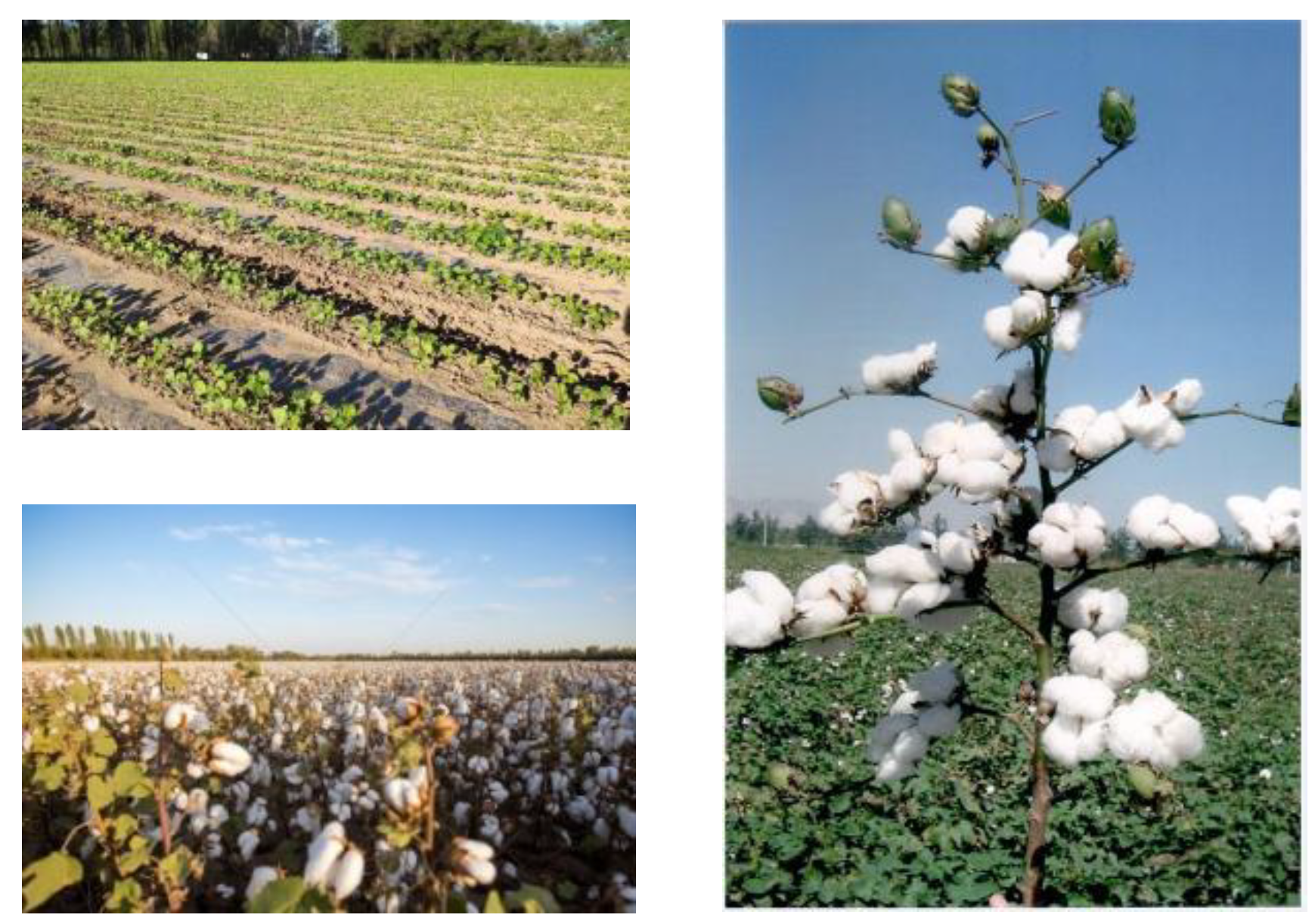

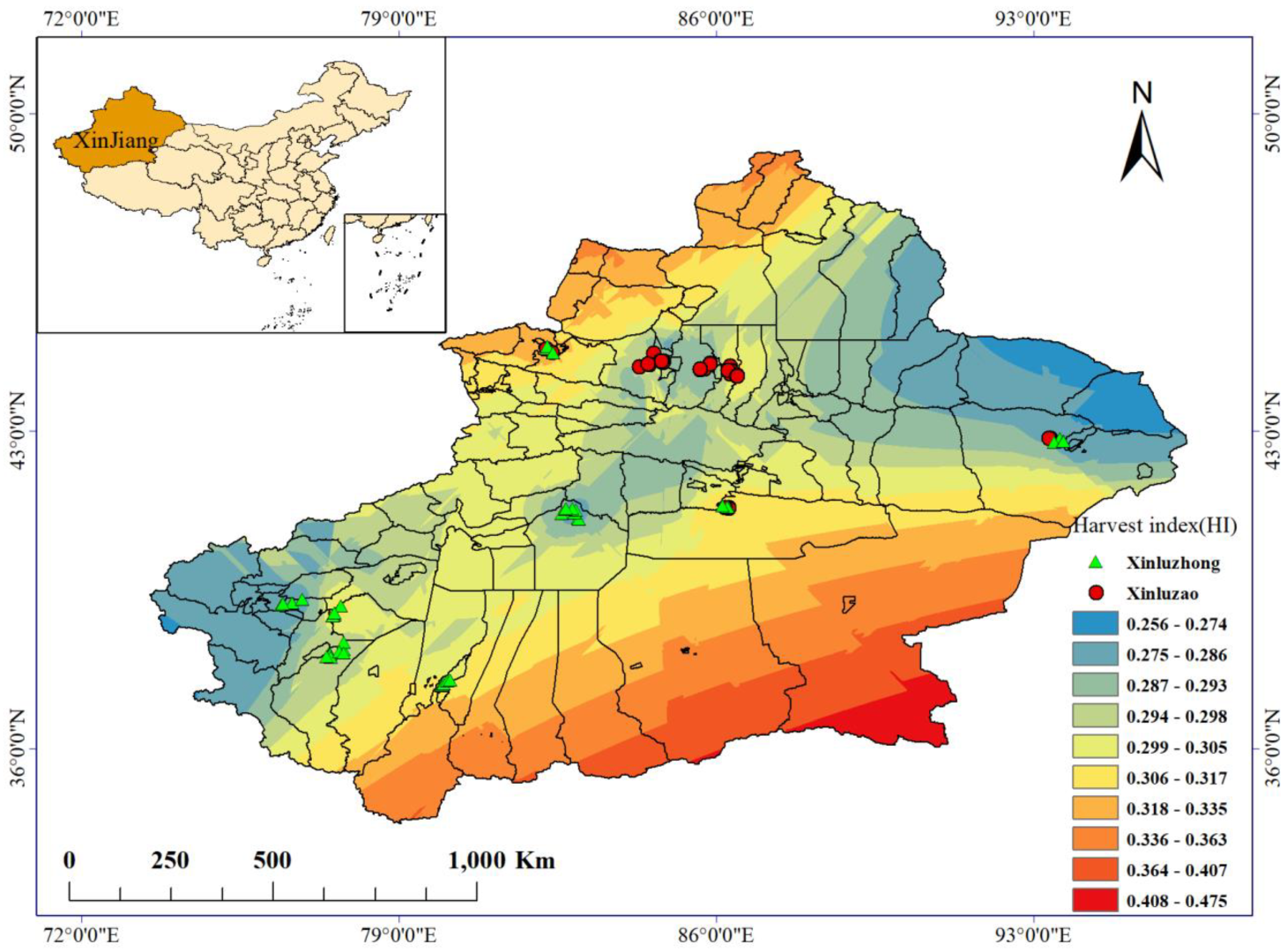
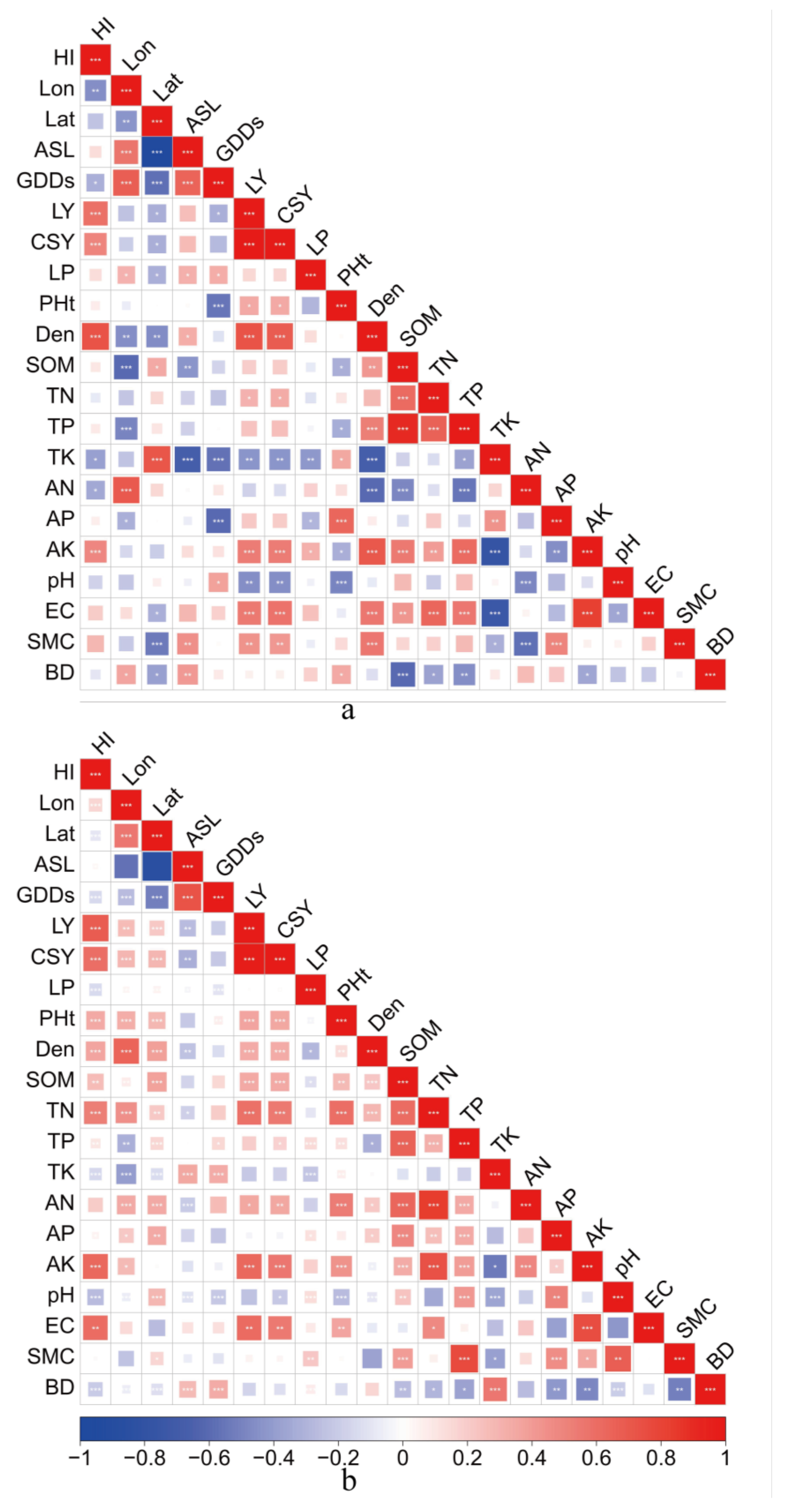
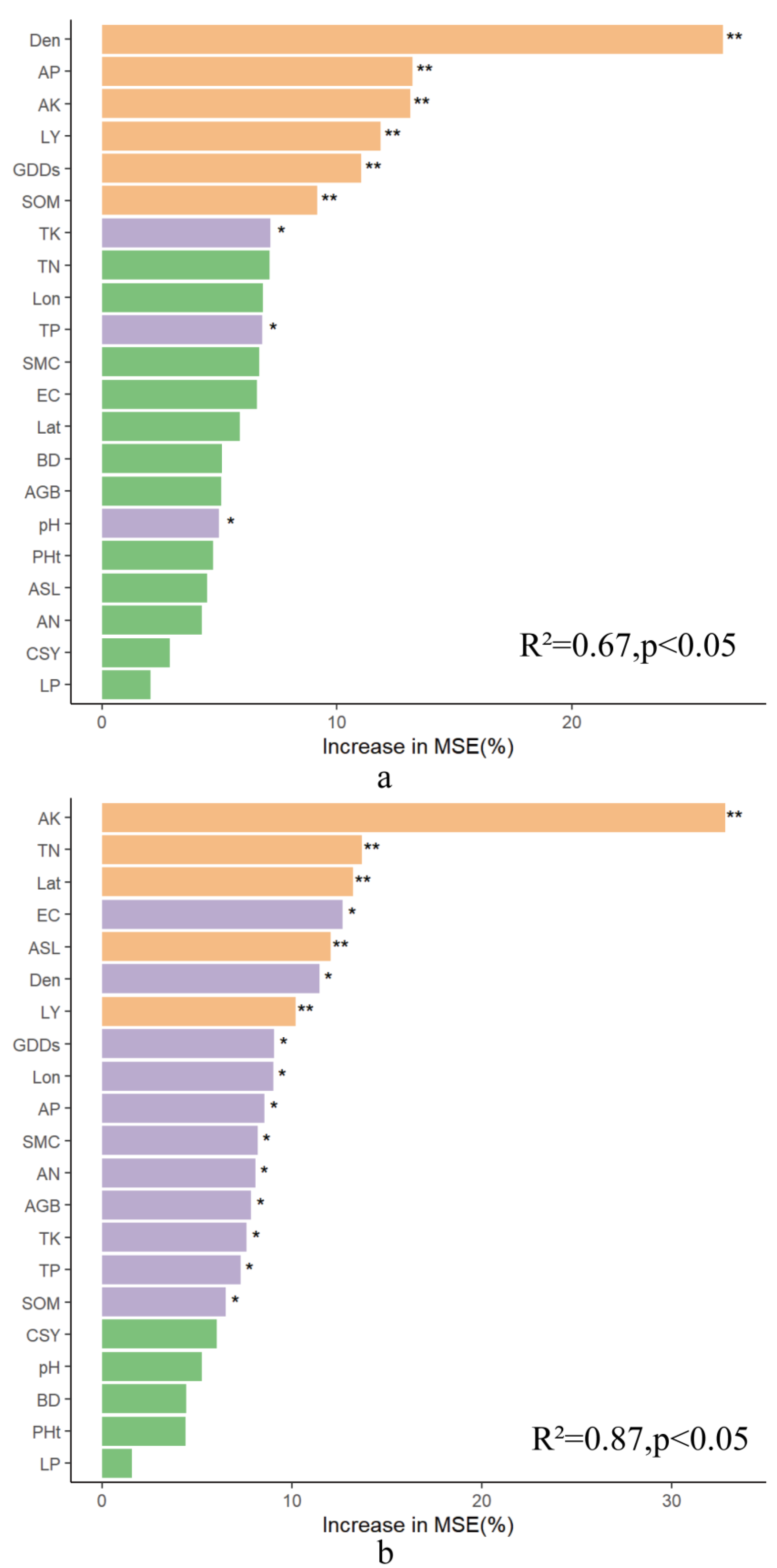
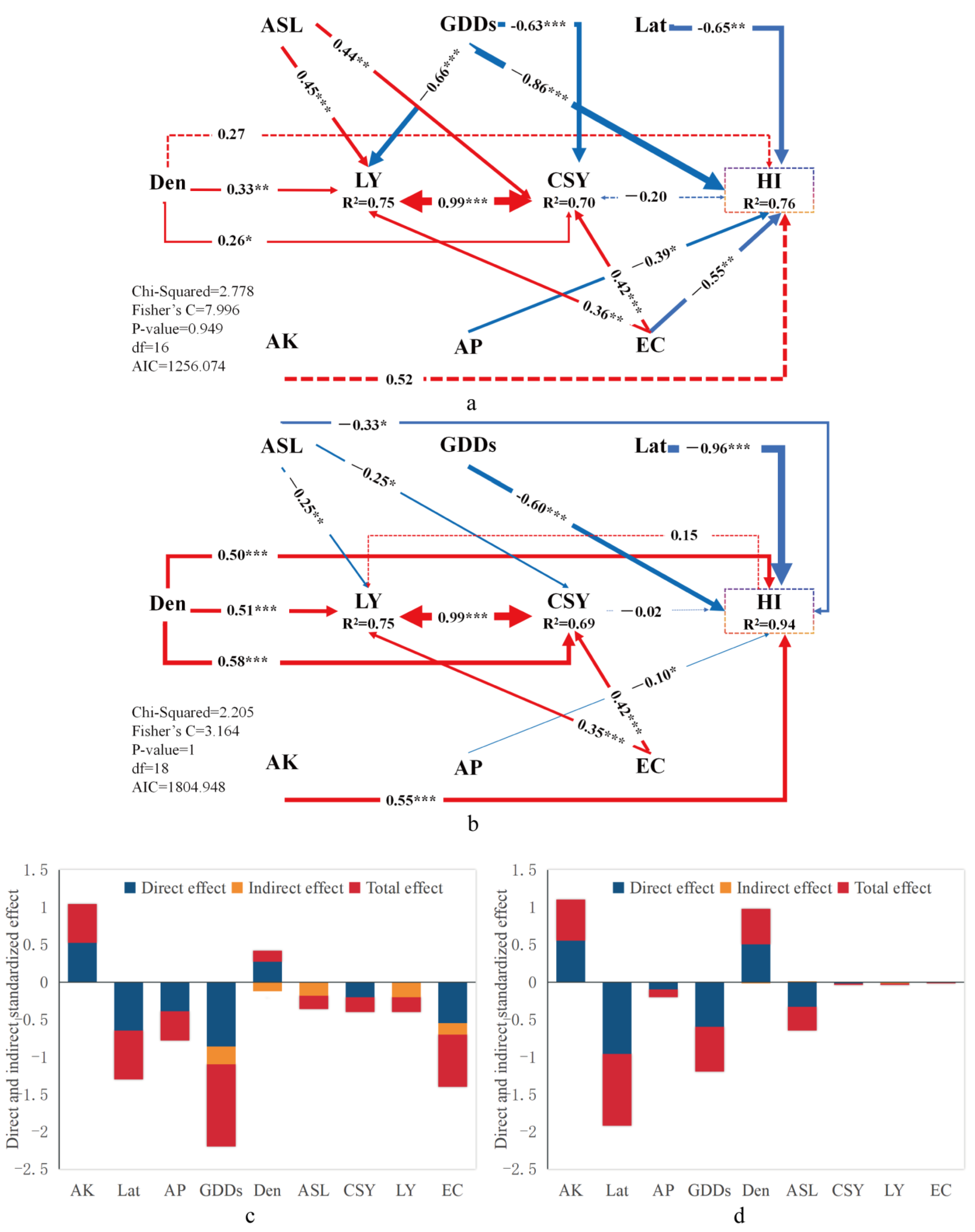
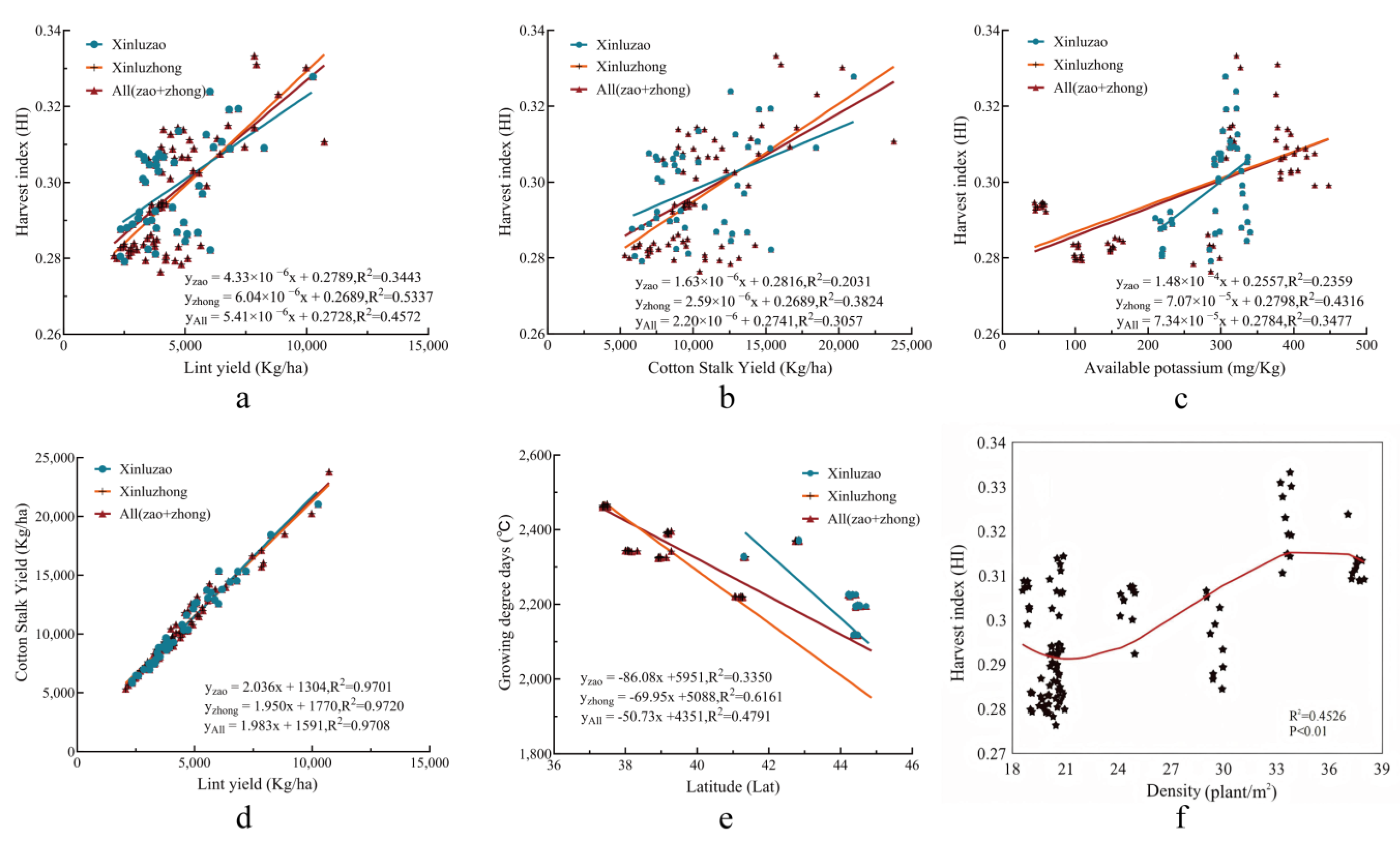
| Nugget C0 | Sill C + C0 | Proportion (C0/C + C0) | Theoretical Model | CV | |
|---|---|---|---|---|---|
| Harvest index | 0.00023 | 0.00117 | 19.66% | Exp | 4.66% |
| ME (10−4) | RMSE (10−2) | RMSSE | |
|---|---|---|---|
| Harvest index | 0.80 | 0.51 | 0.9606 |
Disclaimer/Publisher’s Note: The statements, opinions and data contained in all publications are solely those of the individual author(s) and contributor(s) and not of MDPI and/or the editor(s). MDPI and/or the editor(s) disclaim responsibility for any injury to people or property resulting from any ideas, methods, instructions or products referred to in the content. |
© 2025 by the authors. Licensee MDPI, Basel, Switzerland. This article is an open access article distributed under the terms and conditions of the Creative Commons Attribution (CC BY) license (https://creativecommons.org/licenses/by/4.0/).
Share and Cite
Yang, X.; Yu, W.; Li, Q.; Zhong, D.; He, J.; Dong, H. Latitude, Planting Density, and Soil Available Potassium Are the Key Driving Factors of the Cotton Harvest Index in Arid Regions. Agronomy 2025, 15, 743. https://doi.org/10.3390/agronomy15030743
Yang X, Yu W, Li Q, Zhong D, He J, Dong H. Latitude, Planting Density, and Soil Available Potassium Are the Key Driving Factors of the Cotton Harvest Index in Arid Regions. Agronomy. 2025; 15(3):743. https://doi.org/10.3390/agronomy15030743
Chicago/Turabian StyleYang, Xiaopeng, Wanli Yu, Qve Li, Dongdong Zhong, Jiajing He, and Hegan Dong. 2025. "Latitude, Planting Density, and Soil Available Potassium Are the Key Driving Factors of the Cotton Harvest Index in Arid Regions" Agronomy 15, no. 3: 743. https://doi.org/10.3390/agronomy15030743
APA StyleYang, X., Yu, W., Li, Q., Zhong, D., He, J., & Dong, H. (2025). Latitude, Planting Density, and Soil Available Potassium Are the Key Driving Factors of the Cotton Harvest Index in Arid Regions. Agronomy, 15(3), 743. https://doi.org/10.3390/agronomy15030743






